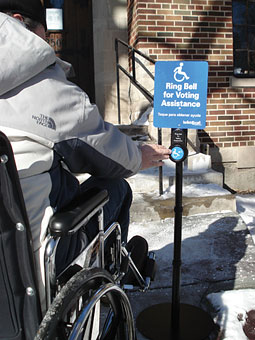 According to a new report issued by the U.S. Government Accountability Office (GAO), while people with disabilities could easily vote on accessible voting machines at the majority of polling places during the 2016 election, they were unable to get inside their polling place to do so.
According to a new report issued by the U.S. Government Accountability Office (GAO), while people with disabilities could easily vote on accessible voting machines at the majority of polling places during the 2016 election, they were unable to get inside their polling place to do so.
Why? The report – which calls on the U.S. Justice Department to take meaningful action to remedy the pervasive issues – notes that at some polling places a person with mobility challenges would have difficulty just getting from the parking lot to the voting booth. In fact, 60 percent of the polling places surveyed had potential impediments outside, including unpaved parking lots, steep walkways, and automatic doors that didn’t work. One polling place even tried to meet accessibility requirements with a makeshift ramp improvised from a folding table and a block of wood. The following barriers to entry were cited most frequently:
- Steep ramps or bad curb cuts outside buildings
- Entrance door thresholds greater than 1/2″
- Lack of way signs to indicate accessible paths
- Poor parking/path surfaces
Unfortunately, these barriers affected a significant number of voters. Approximately 60% of voters with disabilities turned out for the 2016 election, and 15.5% of voters aged 65 to 74 have difficulty walking.
For the review, GAO looked at 178 polling places across the country that were available for early voting and/or Election Day voting during the 2016 cycle. While early voting locations were found to be slightly more at risk of violating ADA requirements – which mandate that public entities choose facilities for activities like voting that do not exclude people with disabilities – of all 178 polling places surveyed, 60 percent had one or more potential impediments outside the polling place. Furthermore, in at least 27 percent of the counties studied by GAO, accessibility was not considered as a criterion for polling place selection.
The GAO report illustrates that compliance with these laws is still lacking, and there continue to be many barriers to casting a ballot for people with disabilities. Stated GAO investigators, “Our work examining the accessibility of polling places for voters with disabilities during the 2000, 2008, and 2016 general elections points to the need for additional progress to help voters with disabilities enter and move through polling places, access voting systems, and cast a private and independent vote.” Most state elections officials told the GAO that in the absence of Help America Vote Act (HAVA) funds, limited financial resources are the main barrier to improving polling place accessibility.
This is where Inclusion Solutions consulting services can add value. We’ve worked with multiple counties and municipalities nationwide that have not only been required to complete election site surveys, but also are under scrutiny from either local disability advocates or the United States Department of Justice regarding polling place accessibility. We realize how difficult it is to remedy barriers without HAVA funds, and our expertise is unmatched when it comes to identifying cost-effective, pragmatic solutions for accessibility for voters with a variety of physical or cognitive disabilities. Talk to one of our experts today!